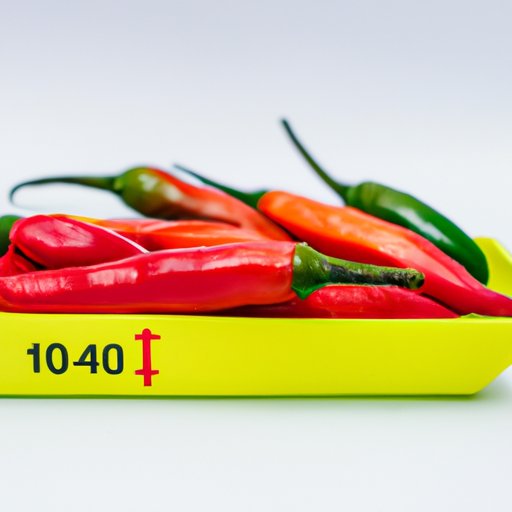Introduction
If you’re a fan of spicy food, you know the thrill of the burn and the rush of endorphins that comes with it. But what is the hottest pepper in the world? And what makes peppers so hot? From the Scoville scale rankings to the health risks of extreme pepper consumption, this article will explore everything you need to know about the world’s spiciest peppers.
The Top 7 Hottest Peppers in the World: What You Need to Know
From the tongue-scorching Carolina Reaper to the fiery Trinidad Scorpion, there are plenty of contenders for the title of the hottest pepper in the world. Here’s a rundown of the top 7:
1. Carolina Reaper – With a Scoville ranking of over 2 million, this pepper is not to be taken lightly.
2. Trinidad Scorpion – Another super-hot pepper with a Scoville ranking of over 1 million.
3. 7 Pot Douglah – This pepper has a unique chocolatey flavor and a heat level similar to the Trinidad Scorpion.
4. Chocolate Bhutlah – A crossbreed between the Bhut Jolokia and the 7 Pot Douglah, this pepper is not only scorching hot but also deliciously smoky.
5. 7 Pot Primo – A pepper with a fruity, citrusy flavor and a Scoville ranking of over 1 million.
6. Trinidad Moruga Scorpion – In 2012, this pepper was declared the world’s hottest but has since been surpassed by others. Still, with a Scoville ranking of over 2 million, it’s not to be underestimated.
7. Bhut Jolokia – Also known as the Ghost Pepper, this pepper held the world record for hottest pepper for several years and has a Scoville ranking of over 1 million.
From Mild to Extreme: A Guide to Understanding Pepper Heat Levels
So how do peppers stack up against each other in terms of heat? It all comes down to the Scoville scale, a measure of the concentration of capsaicin, the compound responsible for the heat in peppers. Here’s a breakdown of the different heat levels:
Mild peppers (0-5000 Scoville units): Bell peppers, banana peppers, poblano peppers, etc.
Medium peppers (5000-50,000 Scoville units): Jalapeño peppers, Serrano peppers, guajillo peppers, etc.
Hot peppers (50,000-250,000 Scoville units): Cayenne peppers, Thai peppers, Tabasco peppers, etc.
Extreme peppers (250,000-2+ million Scoville units): Carolina Reaper, Trinidad Scorpion, 7 Pot Douglah, etc.
Feeling the Burn: Exploring the Science Behind Spicy Peppers
But what exactly makes these peppers so hot? It all comes down to the chemical compound capsaicin. When we eat spicy peppers, capsaicin binds to pain receptors in our mouth and throat, triggering a rush of endorphins and a sensation of heat. This reaction is why some people are addicted to spicy food and why it’s become a cultural phenomenon in many parts of the world. However, too much spice can also have negative health effects, such as acid reflux, ulcers, and even gastrointestinal bleeding.
The Hottest Peppers You Can Grow at Home: Tips for Gardeners
Are you a gardening enthusiast looking to try your hand at growing your own peppers at home? Some of the hottest peppers in the world are actually quite easy to grow, with the right conditions. Here are some tips:
1. Choose a sunny spot with well-draining soil.
2. Water your plants regularly, but be careful not to overwater.
3. Protect your plants from pests like aphids and whiteflies.
4. Harvest your peppers when they’re fully ripe for maximum heat and flavor.
Some of the best varieties for growing at home include the Carolina Reaper, Bhut Jolokia, and Trinidad Scorpion.
How Hot is Too Hot? Understanding the Risks of Extreme Pepper Consumption
While many people enjoy the thrill of eating extremely hot peppers, it’s important to be mindful of the potential risks. Some of the health risks associated with spicy food include:
1. Acid reflux and heartburn.
2. Ulcers and other digestive issues.
3. Gastrointestinal bleeding.
If you experience any of these symptoms after eating spicy food, it’s important to seek medical attention. Additionally, be careful not to overconsume spicy peppers, as this can lead to dehydration and other negative health effects.
Beyond Heat: Discovering the Flavors of the World’s Spiciest Peppers
While many people focus on the heat level of spicy peppers, there’s actually a wide range of unique flavors and aromas to explore as well. Different peppers have different flavor profiles, ranging from sweet and fruity to smoky and savory. Some suggestions for using spicy peppers in cooking include:
1. Adding a kick to soups, stews, and chilis.
2. Using spicy peppers in marinades and rubs for meat.
3. Adding chopped peppers to eggs, omelets, and breakfast dishes.
Hotter Than Hot: Exploring the Cultural Significance of Peppers in Common Cuisine
Peppers have been a staple of many cultures’ cuisine for centuries, from the spicy curries of India to the fiery hot sauces of Latin America. Historically, peppers were used to add flavor and preserve food, but today they’ve become a source of culinary innovation and a symbol of cultural identity. Some current trends in the world of spicy food include:
1. The popularity of hot sauces and spicy condiments.
2. The rise of spicy food challenges and competitive eating.
3. The exploration of new varieties of peppers from all over the world.
Conclusion
The world of spicy peppers is a vast and fascinating one, filled with heat, flavor, and cultural significance. Whether you’re a fan of extreme heat or just looking to add a little spice to your cooking, there’s something for everyone to discover in the world of peppers. So go ahead and try a new variety, grow your own, or explore new recipes and flavor combinations. Your taste buds will thank you.
Are you ready to try the hottest pepper in the world? Make sure to take precautions and be mindful of your health, and enjoy the thrill of the burn.
